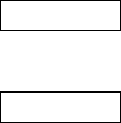
- 108 -
~ In the case of CP code (Two-dimensional code)
Format c [ESC] XBaa; bbbb, cccc, d, e, ff, g, h (, Ciijj) (= kkkk --- kkk) [LF] [NUL]
d [ESC] XBaa; bbbb, cccc, d, e, ff, g, h (, Ciijj) (; ll
1
, ll
2
, ll
3
, --- ll
20
) [LF] [NUL]
Term aa: Bar code number
00 to 31
bbbb: Print origin of X-coordinate of the bar code
Fixed as 4 digits (in 0.1 mm units)
cccc: Print origin of Y-coordinate of the bar code
4 or 5 digits (in 0.1 mm units)
d: Type of bar code
Y: CP code (Two-dimensional code)
e: Designation of ECC (Error Correction Code) level
0: No designation
1: 10%
2: 20%
3: 30%
4: 40%
5: 50%
Only when the number of code characters are specified, can “0” (No
designation) be selected. If “0 (No designation)” is selected without
specifying the number of code characters, the CP code is not printed.
When the number of code characters are specified, blank code areas
created after the characters are encoded should all be filled with ECC
characters.
ff: 1-cell width
00 to 99 (in dots)
g: No. of character bits
0: Set automatically
A: 8 bits
Designates how many bits are used for representing a character.
When “0” is designated, the optimal value is automatically set, according to
data.
h: Rotational angle of the bar code
0: 0°
1: 90°
2: 180°
3: 270°
Ciijj: No. of code characters
(Set automatically when the designation is omitted.)
ii = No. of characters in the X direction: 03 to 22
jj = No. of characters in the Y direction: 02 to 22
“Character” is a unit for code for encoding the CP code.
1 character occupies a 3×3 square block.
When a value for “jj” larger than “ii” is set, an error occurs.
The number of cells for the code is as follows.
(No. of characters × 3 +2)
kkkk --- kkk: Data string to be printed (Omissible)
Max. 473 digits
ll
1
, ll
2
, ll
3
, --- ll
20
: Link field No. (Omissible)
01 to 99 (1 to 99 can also be used.)
Up to 20 digits can be designated using commas.


















